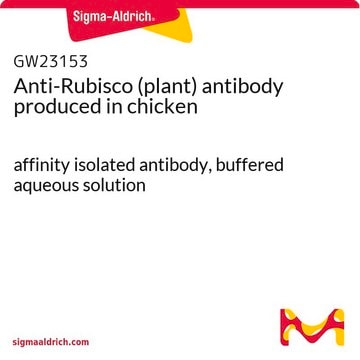R8000
D-Ribulose 1,5-Diphosphate Carboxylase from spinach
partially purified powder, 0.01-0.1 unit/mg solid
Synonym(e):
3-Phospho-D-glycerate carboxy-lyase(dimerizing), Rubisco
About This Item
Empfohlene Produkte
Biologische Quelle
spinach
Form
partially purified powder
Spezifische Aktivität
0.01-0.1 unit/mg solid
Mol-Gew.
557 kDa
Lagertemp.
−20°C
Verwandte Kategorien
Allgemeine Beschreibung
pH optimum: ~7.9.
KM for CO2: ~0.45 mM.
Ribulose diphosphate becomes inhibitory at concentrations exceeding 0.7 mM. Orthophosphate and ammonium sulfate are competitive inhibitors. 3-Phosphoglycerate is a noncompetitive inhibitor.
Anwendung
- as a test protein in pepsin digestion studies
- as an innocuous or non-hazardous protein sample to test its effect on human intestinal epithelial cell lines
- in isothermal titration calorimetry (ITC), and radiolabeled binding assays with abscisic acid
Biochem./physiol. Wirkung
Einheitendefinition
Signalwort
Danger
H-Sätze
P-Sätze
Gefahreneinstufungen
Resp. Sens. 1
Lagerklassenschlüssel
11 - Combustible Solids
WGK
WGK 1
Flammpunkt (°F)
Not applicable
Flammpunkt (°C)
Not applicable
Persönliche Schutzausrüstung
Eyeshields, Gloves, type N95 (US)
Analysenzertifikate (COA)
Suchen Sie nach Analysenzertifikate (COA), indem Sie die Lot-/Chargennummer des Produkts eingeben. Lot- und Chargennummern sind auf dem Produktetikett hinter den Wörtern ‘Lot’ oder ‘Batch’ (Lot oder Charge) zu finden.
Besitzen Sie dieses Produkt bereits?
In der Dokumentenbibliothek finden Sie die Dokumentation zu den Produkten, die Sie kürzlich erworben haben.
Unser Team von Wissenschaftlern verfügt über Erfahrung in allen Forschungsbereichen einschließlich Life Science, Materialwissenschaften, chemischer Synthese, Chromatographie, Analytik und vielen mehr..
Setzen Sie sich mit dem technischen Dienst in Verbindung.







